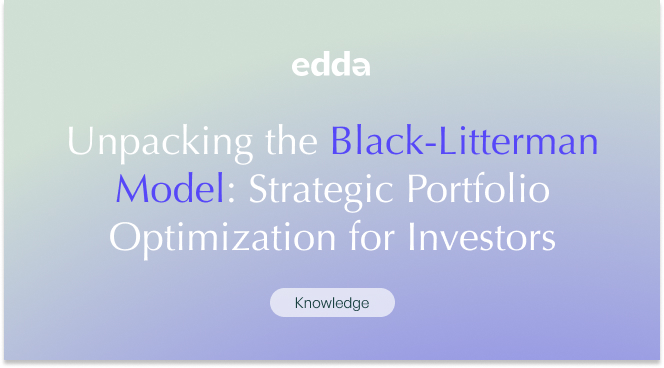Unpacking the Black-Litterman Model: Strategic Portfolio Optimization for Investors
When it comes to portfolio management, the Black-Litterman model represents a sophisticated and structured approach. This model, developed by Fischer Black and Robert Litterman at Goldman Sachs, offers a blend of theoretical and practical elements that provide portfolio managers with a way to integrate their market insights with the expected market equilibrium.
This detailed examination aims to dissect the workings of the Black-Litterman model, shedding light on its application, methodology, and the reflective consideration of its strengths and weaknesses in portfolio management.
In addition, discover how advanced dealflow software and portfolio monitoring tools can help you effectively navigate the complexities of portfolio management.
Anatomy of the Black-Litterman Model
The Black-Litterman model was conceived to improve upon the classical mean-variance optimization framework. It allows the incorporation of an investor’s unique views into the market’s equilibrium model, enabling a more customized and potentially more realistic asset allocation.
The model operates by taking the expected market returns, often derived from the Capital Asset Pricing Model (CAPM), and melding these with the investor’s own forecasts regarding the returns of various assets. This combination is executed in a manner that adjusts for the confidence level in those forecasts, resulting in a recalibrated set of asset weights aimed at achieving the desired balance between risk and performance.
This approach requires complex calculations, often performed with computational support, to manage the complex data and produce actionable portfolio strategies. Here’s the simplified process:
- Starting Point: It begins with the market’s expected returns, often based on the Capital Asset Pricing Model, assuming the market portfolio is efficiently balanced according to available data and consensus.
- Personal Views: Investors incorporate their own forecasts for certain assets, which might differ from market expectations.
- Confidence Levels: The model quantifies how confident investors are in their forecasts, influencing the extent to which these views will alter the portfolio.
- Mixing Forecasts: Personal forecasts are statistically blended with market expectations, weighted by the investor’s confidence levels.
- Optimized Portfolio: The adjusted forecasts are then utilized to optimize the asset mix in the portfolio, seeking to achieve a desired risk-return profile.
- Refinement: If the optimization suggests impractical allocations, investors may need to reassess their forecasts or confidence levels and re-optimize.
Application of the Black-Litterman Model
The Black-Litterman model brings a level of customization to portfolio management that is both responsive to the investor’s insights and anchored in market realities. It is particularly useful for investors who have specific viewpoints about certain sectors or regions and wish to see these reflected in their investments.
By calibrating the strength of these views against market data, the model ensures that portfolios are not just tailored, but also resilient, capable of withstanding market fluctuations without veering too far from an investor’s core beliefs. Here’s how:
Tailored Portfolio Assembly
The Black-Litterman model excels at creating a financial portfolio that reflects an investor’s particular outlook. For example, consider a scenario where an investment advisor’s client anticipates that the education technology sector will thrive due to a shift towards online learning. Traditionally, a portfolio might have a minor allocation to this niche sector based on broad market indexes.
However, using the Black-Litterman model, the advisor can fine-tune the portfolio to overweight education technology stocks while maintaining an appropriate risk level. The result is a personalized portfolio where the investor’s specific expectation is given greater emphasis but still tempered by the overall market’s pricing of assets.
Measured Risk Control
With this model, investors can calibrate their portfolios according to how strongly they feel about their market predictions. For instance, a hedge fund manager may predict a downturn in the real estate market due to an anticipated increase in interest rates.
If they have a high degree of confidence in this prediction, the Black-Litterman model can significantly reduce the portfolio’s exposure to real estate investment trusts (REITs). Conversely, if the manager is less certain, the model might suggest a more moderate reduction. This nuanced adjustment allows for a risk management approach that directly correlates with the level of conviction in the manager’s predictions, leading to a tailored risk profile for the portfolio.
Informed Asset Distribution
This model facilitates a judicious allocation of resources across various investments, merging the investor’s specific insights with general market forecasts. Take the case of a portfolio manager at a global asset management firm who foresees increased infrastructure spending in developing economies.
Using the Black-Litterman model, the manager can integrate this view with existing market data to shift the portfolio towards infrastructure-related equities in those economies. By doing so, the model helps in strategically increasing the allocation to these equities based on the manager’s insights, but not to the extent that it ignores market valuations and risk factors of other assets within the portfolio.
Limitations of the Black-Litterman Model
The Black-Litterman model, while revolutionary in portfolio management, presents a few core limitations that significantly impact its practical application.
Complexity and Implementation Hurdles
One of the most considerable challenges is the model’s complexity. Its sophisticated mathematical framework is daunting, requiring advanced knowledge in both finance and statistics, as well as access to powerful computational resources. This barrier can preclude a wide range of investors, particularly smaller firms or individual practitioners, from taking full advantage of the model’s capabilities.
The Pitfalls of Subjective Inputs
Another significant limitation is the reliance on subjective inputs. The model’s effectiveness is directly tied to the accuracy of the investor’s views. Misjudgments or biases in these inputs can lead to allocations that are misaligned with optimal portfolio performance.
Furthermore, quantifying the degree of confidence in these views introduces additional subjectivity, making it challenging to gauge the true level of conviction behind each input and thus to balance them appropriately within the model.
Equilibrium and Historical Data Constraints
The model’s dependence on the notion of market equilibrium for its baseline returns is also a critical limitation. Market equilibrium is a theoretical state that may not always represent the actual market environment. Moreover, the use of historical data to inform this equilibrium assumes that past trends will continue into the future, which is often not the case, especially in volatile or rapidly evolving markets.
Secondary Limitations
There are also several secondary constraints to consider. The estimation of the covariance matrix for risk assessment is a technical challenge, with inaccuracies potentially leading to significant optimization errors. Assumptions of market efficiency and normally distributed returns can be problematic during irregular market conditions. Furthermore, the model does not inherently account for liquidity considerations or the impact of transaction costs, which can be decisive factors in real-world trading.
While the Black-Litterman model offers a structured approach to incorporating investor insight into market-based portfolios, it demands a high degree of technical skill and confidence in the subjective estimates provided by the investor.
Recognizing these primary limitations is essential for those looking to employ the model, and should lead to a cautious application, supplemented by comprehensive research and risk management.
Manage Your Financial Portfolio with Edda
Edda’s VC portfolio management software delivers critical support to investors implementing the Black-Litterman model within their portfolio management operations. Our venture capital management software equips users with robust data analysis and management features, enabling a seamless integration of personal market perspectives into a broader economic framework.
Edda’s deal flow system enhances the optimization of asset allocation, streamlining the infusion of individual insights into the global market context, as necessitated by the Black-Litterman approach. For investors navigating the complexities of blending subjective views with objective market equilibria, Edda offers a substantial advantage, ensuring their strategic decisions are well-informed and data-centric.
Edda’s venture capital portfolio management software simplifies the task of monitoring investment pipelines and managing portfolio diversification, effectively reinforcing the decision-making process. This proves invaluable for investors who require a dynamic and rigorous tool to support a sophisticated portfolio management strategy in line with the Black-Litterman model’s refined principles.









